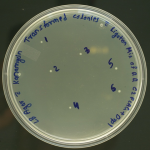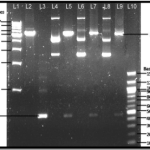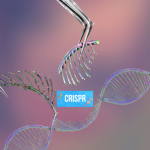Alkaline Lysis method is one of the most common methods for extracting plasmid from bacteria. The method was originally developed by Birnboim and Dolly in 1979. Although several modifications have been made to the original protocol, the underlying principle remains unchanged. The protocol is based upon the fact that Covalently Closed Circular DNA (CCC-DNA) has the property to remain stable over a certain pH range where linear DNA tends to denature (about 12.0-12.5)1. You can find the modified protocol here.
The following descriptions have been made for the solutions used in the modified protocol.
- Alkaline Lysis Solution I: [Needs to be autoclaved for sterilization] – Resuspension Buffer
A. 50 mM Glucose: Glucose helps to maintain the osmotic pressure in cells such that they can remain free from each other, which helps to ensure their disruption in the latter stage. Since it has a pKa of 12.3, it also acts as a buffer to maintain pH.
B. 25 mM Tris-HCl (pH 8.0): Tris present under alkaline conditions helps in the denaturation of DNA2.
C. 10 mM Ethylenediaminetetraacetic acid (EDTA) (pH 8.0): EDTA helps in the destabilization of membranes and inhibits DNases activity by acting as a chelating agents (Binds metal ion)3.
- Alkaline Lysis Solution II: [Needs to be freshly prepared before the experiment] – Alkaline Lysis Buffer
A. 0.2N NaOH: It causes denaturation of genomic DNA as well as cellular proteins.
B. 1 % Sodium Dodecyl Sulphate: It disrupts cell membrane by dissolution of phospholipids and protein contents.
- Alkaline Lysis Solution III: [For 100 ml] – Neutralization Buffer
A. 5 M Potassium Acetate: 60 ml: In combination with glacial acetic acid, it acts as a neutralization buffer. High salt concentration leads to formation of white precipitate containing SDS, lipids, cellular debris including denatured genomic DNA. This neutralization also leads to renaturation of DNA, where due to its larger size, genomic DNA gets further entangled while plasmid DNA owing to its smaller size remains intact2.
B. Glacial Acetic Acid: 11.5 ml
C. Deionized water: 28.5 ml: For maintaining the final volume.
References:
1. Birnboim H, Doly J. A rapid alkaline extraction procedure for screening recombinant plasmid DNA. Nucleic Acids Res. 1979;7(6). http://nar.oxfordjournals.org/
2. Salwan R, Sharma V. Chapter 12 – Expression of recombinant proteins in prokaryotic host. In: Salwan R, Sharma V, eds. Laboratory Methods in Microbiology and Molecular Biology. Developments in Microbiology. Academic Press; 2023:145-153. doi:https://doi.org/10.1016/B978-0-323-95078-7.00007-3
3. George T, Brady MF. Ethylenediaminetetraacetic Acid (EDTA) [Updated 2023 Jun 26]. In: StatPearls [Internet]. Treasure Island (FL): StatPearls Publishing; 2024 Jan-. Available from: https://www.ncbi.nlm.nih.gov/books/NBK565883/
Related Articles:
Plasmid DNA Extraction from Bacteria by Alkaline Lysis Method
Manual Technique for Extraction of DNA from Bacteria







